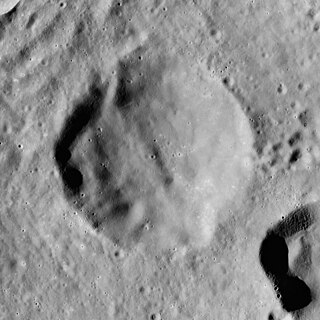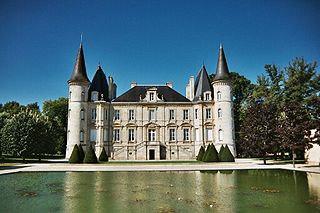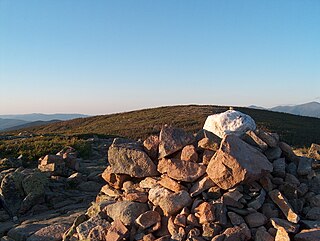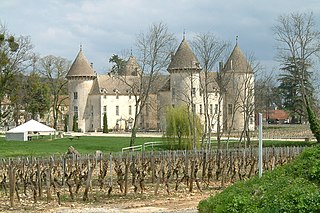
Bingham is a small lunar impact crater that is located on the far side of the Moon, relative to the Earth. It is named after the American academic, explorer and politician Hiram Bingham III. It lies just to the southeast of the much larger crater Lobachevskiy, and the northwestern part of the rim of Bingham is partly overlaid by ejecta from Lobachevsky. To the northeast of Bingham is the crater Guyot, and about a crater diameter to the south-southeast is Katchalsky. This is a roughly circular crater formation with a slight outward bulge along the southeastern side.

Arnold Henry Guyot was a Swiss-American geologist and geographer.

King is a prominent lunar impact crater that is located on the far side of the Moon, and can not be viewed directly from Earth. The crater was named after Arthur Scott King and Edward Skinner King in 1970. Prioir to that, this crater was known as Crater 211. It forms a pair with Ibn Firnas, which is only slightly larger and is attached to the northeast rim of King. To the northwest is the crater Lobachevskiy, Guyot is located an equal distance to the north-northwest.

Touriga Nacional is a variety of red wine grape, considered by many to be Portugal's finest. Despite the low yields from its small grapes, it plays a big part in the blends used for ports, and is increasingly being used for table wine in the Douro and Dão. Touriga Nacional provides structure and body to wine, with high tannins and concentrated flavors of black fruit. Jancis Robinson has compared its relationship with Touriga Francesa to the partnership between Cabernet Sauvignon and Cabernet Franc, the former providing structure, the latter filling out the bouquet.
Lawrence Guyot Jr. was an American civil rights activist who was the director of the Mississippi Freedom Democratic Party in 1964.

Ostwald is a lunar impact crater on the far side of the Moon. It lies just to the east of the crater Guyot, and near the northern border of Ibn Firnas. Recht lies along its eastern rim.

Kostinsky is a lunar impact crater on the far side of the Moon. It is nearly attached to the northeastern outer rim of the crater Guyot. About one crater diameter to the southeast is Ostwald, and farther to the north is Olcott.

Château Pichon Longueville Baron or Château Longueville au Baron de Pichon-Longueville is a winery in the Pauillac appellation of the Bordeaux region of France. Château Pichon Longueville Baron is also the name of the red wine produced by this property. The wine produced here was classified as one of fifteen Deuxièmes Crus in the original Bordeaux Wine Official Classification of 1855.

Mount Guyot is a mountain located in Grafton County, New Hampshire. The mountain is named after Professor Arnold H. Guyot (1807–1884) of Princeton University, and is part of the Twin Range of the White Mountains. Mount Guyot is flanked to the northwest by South Twin Mountain, to the northeast by Mount Zealand, and to the south by Mount Bond. Guyot is on the northern boundary of the Pemigewasset Wilderness. The immediate area around the summit consists of high-altitude spruce-fir forest or krummholz.
Venetian wine is produced in Veneto, a highly productive wine region in north-eastern Italy.

Dr. Jules Guyot was a French physician and agronomist who was born in the commune of Gyé-sur-Seine in the department of Aube. Guyot studied medicine in Paris, and had an avid interest in mechanics, physics and telegraphy, but he is best known for his work in viticulture.
Jingū Seamount, also called Jingū Guyot, is a guyot of the Hawaiian-Emperor seamount chain in the Pacific Ocean. It erupted 55 million years ago. The seamount is elongated in structure, running north–south, and has an oval shaped crater in the center, which is evidence of collapse when above sea level.
Château Clarke is a wine property of Bordeaux of 54 hectares based in the Listrac-Médoc AOC and classified as Cru Bourgeois.

The use of vine training systems in viticulture is aimed primarily to assist in canopy management with finding the balance in enough foliage to facilitate photosynthesis without excessive shading that could impede grape ripening or promote grape diseases. Additional benefits of utilizing particular training systems could be to control potential yields and to facilitate mechanization of certain vineyard tasks such as pruning, irrigation, applying pesticide or fertilizing sprays as well as harvesting the grapes.

Mount Guyot is a high mountain summit in the Front Range of the Rocky Mountains of North America. The 13,376-foot (4,077 m) thirteener is located 6.3 miles (10.2 km) east-southeast of the Town of Breckenridge, Colorado, United States, on the Continental Divide separating Pike National Forest and Park County from Arapaho National Forest and Summit County. The mountain was named in honor of Arnold Henry Guyot, a Swiss-American geologist.

Ruwitūn̄tūn̄ is a guyot in the Pacific Ocean which reaches a depth of 1,215 metres (3,986 ft) below sea level. It is capped off with a summit platform covered in sediments and some volcanic pinnacles with craters. Basaltic rocks have been found on Ruwitūn̄tūn̄.

Darwin Guyot is a volcanic underwater mountain top, or guyot, in the Mid-Pacific Mountains between the Marshall Islands and Hawaii. Named after Charles Darwin, it rose above sea level more than 118 million years ago during the early Cretaceous period to become an atoll, developed rudist reefs, and then drowned, perhaps as a consequence of sea level rise. The flat top of Darwin Guyot now rests 1,266 metres (4,154 ft) below sea level.
This page is based on this
Wikipedia article Text is available under the
CC BY-SA 4.0 license; additional terms may apply.
Images, videos and audio are available under their respective licenses.














